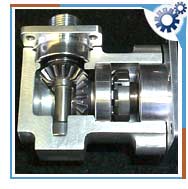Input and output configurations for gearboxes include hollow shaft or coupling or bushing. A single input shaft can drive multiple output shafts. The output shafts are usually parallel and in-line. However, some unique configurations exist that allow for offset shafts to be driven at different speeds. Some gearboxes are supplied with a reaction arm. A reaction arm prevents the reducer housing from rotating when there is no base mounts or flanges. Shaft alignment can be parallel in-line, parallel offset, right angle and non-perpendicular angled shafts.
Gearbox is intended to be incorporated in a transmission for vehicles, particularly terrain vehicles, preferably driven by an internal combustion engine.
Gearing Arrangement for Gearbox
Gearing arrangement for gearbox includes spur, helical, planetary, bevel, worm, and cycloidal. Bevel gear is a gear wheel meshed with another so that their shafts are at an angle less than 180degrees. They connect intersecting axes. Helical gears connect parallel shafts but the involute teeth are cut at an angle to the axis of rotation. Two mating helical gears must have equal helix angle but opposite hand. Spur gears connect parallel shafts, have involute teeth that are parallel to the shaft and can have internal or external teeth. Planetary gears are a set of gears usually two or more on or inside a larger gear. They make drastic gear ratio possible. They are used when one wishes to turn the input in the same direction as the output. Planetary reducers can be designed with gear sets or a set of planetary cones. Cycloidal gears are used in pairs and are set at an angle of 180 degrees used to balance the load and are driven by multiple crank shafts to share the load and increase torsion rigidity. Cycloid reducers use rolling elements and a multilobe cam to transmit torque and provide speed reduction. A worm gear is an inclined plane wrapped around a central axle. It is a gear with one or more teeth in the form of screwed threads.
 Types of Gearbox
Types of GearboxThere are two types of gearboxes:
Automatic gearbox:
Several factors have contributed to the development of automatic gearbox. Firstly, the advent of electronics in the nineties and secondly, the wish of having more gear speed. It is used for power transmission and offers automatic gearshift. Automatic gearboxes are easy and pleasurable to drive. The only thing to be done after engaging a gear is to press the accelerator to go and press the brake to stop. The automatic gearboxes relies on hydraulic fluid pressure to shift the gears up and down. This fluid needs to be checked regularly.
Manual gearbox:
Manual gearbox has widely spread into the market but Europeans still remain faithful to manual gearbox. The manual gearbox has been as old as the car itself. These gearboxes use conventional clutch that is activated each time a gear is selected by an electronically controlled motor. This then disengages the clutch, the gear is shifted and the clutch engages once more. It all happens within a second and the system even allows for the car to come to a stop whilst still in gear. The manual gearbox is virtually maintenance free except for the checking of the oil level occasionally.
Controlling Gear Box Contamination
Wear and tear is common in gearboxes. Wear commonly occurs as a result of the contamination and degradation of the lubricant. Proactive maintenance is a well-documented concept. It leads to longer life of the gearbox. In a gearbox, there are moving components that transmit power through rotation and so degradation of lubricant can lead to adhesion, abrasion and corrosion of component surfaces, which finally leads to component failure.
The oil used for lubrication must be free from contamination. Seals have the ability to seal against oil leakage. Breathers are used for allowing airflow on the gearbox. This is to allow for changes in volume as a result of top-ups, leakage and temperature-related volume changes.
An annual check of all switches and sensors should be performed to verify operation as per lubrication system settings. Pumps and other motorized accessories should be checked at scheduled intervals. Flows and pressure drops at the cooler, filters and inlet to the rotating equipment should be routinely monitored and recorded to identify any adverse trends. An annual check of cooler condition is important to maintain cooler efficiency.